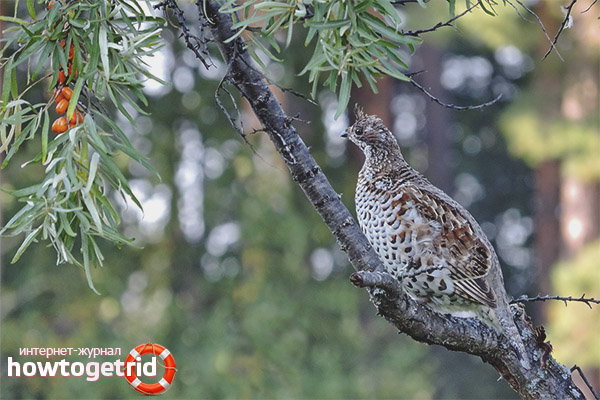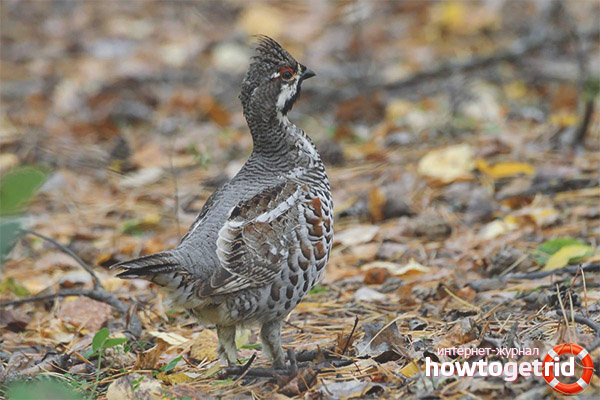The content of the article
Grouse belong to the grouse subfamily. On the territory of Eurasia, birds of this species live in very many areas. They live in the taiga, in western Europe. Habitat extends to Korea. Among all members of the subfamily, representatives of this species are small in size.
Description
The length of the bird is 35-37 cm on average. The wingspan is about half a meter. The hazel grouse is small in weight: males - 330-585 g, females - about 20 g less. The mass of hazel grouses can vary depending on the season. For the winter, they gain a little weight, so in December their weight reaches its peak. Over the winter, they lose weight.
The bird has a small head. It has a powerful and short beak, has a curved shape. Its length is about 1 cm. The bird has colorful feathers. In the coloring there are stripes and specks of various colors - white, black and red.But between them there is no bright contrast, therefore, if you look at grouse from a distance, you get the impression that the bird is smoky gray. When it flies, a dark band is visible near the base of the tail.
In the throat area of the male there is a black spot. His crest on his head is more pronounced than that of the female. But otherwise, representatives of different sexes are not very different from each other. You can distinguish them by the color of the throat and the lower part of the head, which in the female are gray in color, while in the males these parts have black plumage. The female has a slightly smaller size, but there is no significant difference. In autumn and winter, the bird looks a little lighter.
Nutrition
In summer and spring, this bird has the opportunity to find food on the ground. She eats a variety of seeds, berries. Hazel can easily eat any insect or spider, but they eat such food much less often. Representatives of the species that live southward feed on beetles, ants, and other insects.When summer ends and autumn begins, the bird feeds on mountain ash, pecking it off from the trees.
It is more difficult to find food in the autumn and winter for the bird. Hazel grouse eats buds, tips of branches, and also earrings of trees. In winter, the bird can eat them even in the icy state.
When the chicks hatch, they eat animal food. In the first days of their food consists of ant eggs, some insects. But soon they begin to feed in the same way as adults do. Eat berries and greens.
To make the grouse's digestion proceed normally, they regularly eat very small stones. When the chick reaches ten days of age, he already begins to swallow particles of sand or fine limestone. Instead of pebbles, sometimes they eat bones of wild rose or bird cherry.
Habitat
This bird lives in Eurasia. She lives in forests located from the west of Europe to Japan itself. The western boundary of the range - France. In the south and east, they are distributed to Altai and Korea. The bird can be found on Sakhalin.
Today it is noted that the habitat of hazel grouses is breaking up, and the number of representatives of the species decreases. This is due to the fact that man is doing more and more harm to nature.
Grouse dwells in mixed forests with glades and streams.
Kinds
- Ryabchik Severtsova. This bird in length reaches 33-36 cm. Weight 295-370, females 20-50 g less. Plumage in representatives of the species as in the usual grouse. They live in China and Tibet.
- Collar. The body has a length of 42-47 cm. The length of the beak is about 2 cm. This grouse weighs half a kilogram or more. Sometimes the weight can even reach 800 g. The individuals living in the north have gray plumage, while the southern inhabitants have a red-brown color. They have a motley color. These grouse live in North America, in countries such as the United States and Canada. They live in forests, meadows, rocks that are covered with vegetation.
Gender distinction
The difference in the sexes of this species is in the smaller size of the female. In addition, there are differences in the plumage of birds. In males, the lower part of the head has a black color. Their neck is also black. In the female, these parts of the body are covered with gray plumage. The crest of the male is more pronounced. In addition, there is a small black spot on his throat.
Breeding
Representatives of the species are monogamous birds. In addition, they choose for themselves a certain breeding area, to which they then remain attached. The period of overcurrent comes with the onset of a thaw. In the habitat of these birds, this time falls on the second half of March or the beginning of April. The period may last until about May, but may continue even until July. It depends on what climate zone they live in.
When the male starts to current, he makes whistling sounds, spreads feathers. The bird runs on the surface of the earth with open wings and tail.
Each male has its own territory for this. On foreign territory they do not go. When the female hears these sounds, she approaches, and begins to emit her characteristic sounds. They are also whistling, but more rough and jerky.
The nest is built by a female. It is located not on the trees, but on the ground. The bird chooses a place that will be invisible to predators or other threats. May be under a bush or fallen trees. Grouse makes a small hole, which is lined with foliage and grass. The depth of the nest is usually about 5 cm. Its diameter is about 20 cm or a little more.Egg laying starts in May.
Eggs have a smooth surface. At one time, the female may lay a different number of eggs, it ranges from 3-14 pieces. The female is engaged in incubation. But the male does not fly away from the nest. Since the female has a variegated coloring, it allows her to mask and be almost imperceptible to predators.
After 21 days, chicks appear. They immediately have downy plumage and are able to run on the ground on the first day. A day after the birth of the hare hen chick is looking for small insects. Females help chicks find food. The male is always close to his family.
After 2 weeks, the chicks begin to grow actively. Already at two months of age, their weight corresponds to the weight of an adult individual. When the molting period passes, the chicks begin to live independently.
Vote
Interesting Facts
- In winter, these birds sleep in the snow.
- Approximately 40 million grouse live in Russia. The population is declining, but today there is no threat to the species.
- The meat of this bird belongs to the delicacies. Earlier in the days of Tsarist Russia, as well as during the existence of the USSR, a huge number of grouse was exported abroad. Today, sport hunting for these birds is very popular.
Video: hazel grouse (Bonasa bonasia)













To send